Vegetable/Herb of the Week: Peppers (Capiscum spp.)
Frank Mangan and Heriberto Godoy-Hernandez
To read individual sections of this article, click on the section headings below to expand the content:
Welcome to this fourth article of Franco and Beto’s series on growing your own vegetables and herbs in Massachusetts.
Introduction
 Peppers (Capiscum spp.) are an important fruiting vegetable used in cuisines throughout the world. (Note: When there are multiple species within one genus, as is the case with peppers, we put spp. after the genus.) Like tomatoes, the focus of last week’s column, peppers are also in the Solanaceous family, frost sensitive, native to the tropical Americas and brought to Eurasia after the arrival of the Spanish and Portuguese to the Americas. (Note: Unlike tomatoes, some pepper types are also native to Brazil.) Columbus sailed west from Europe on his first voyage, expecting to find a sea route to Asia, an important source of spices which were being brought to Europe over a long land route in Eurasia. Instead, Columbus arrived in the Americas, which initiated one of the most important exchanges of crop species in the history of world. The Spaniards eventually found peppers in Mexico, which the Aztecs called chilli in their language, Nahuatl. Today the most common name for peppers in Mexico are chile, referring to both hot and sweet types (Figure 1).
Peppers (Capiscum spp.) are an important fruiting vegetable used in cuisines throughout the world. (Note: When there are multiple species within one genus, as is the case with peppers, we put spp. after the genus.) Like tomatoes, the focus of last week’s column, peppers are also in the Solanaceous family, frost sensitive, native to the tropical Americas and brought to Eurasia after the arrival of the Spanish and Portuguese to the Americas. (Note: Unlike tomatoes, some pepper types are also native to Brazil.) Columbus sailed west from Europe on his first voyage, expecting to find a sea route to Asia, an important source of spices which were being brought to Europe over a long land route in Eurasia. Instead, Columbus arrived in the Americas, which initiated one of the most important exchanges of crop species in the history of world. The Spaniards eventually found peppers in Mexico, which the Aztecs called chilli in their language, Nahuatl. Today the most common name for peppers in Mexico are chile, referring to both hot and sweet types (Figure 1).
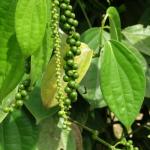 The Spaniards called the Capsicum species they found in Latin America pimienta, which translates to “pepper” in English, since they thought it was related to black pepper, Piper nigrum (Figure 2), also known for being spicy and a common and important spice in Eurasia. Seeds of Capsicum spp. were brought back to Europe by the Spanish and Portuguese, and within a century Capsicum spp. were found in cuisines throughout Eurasia and Africa.
The Spaniards called the Capsicum species they found in Latin America pimienta, which translates to “pepper” in English, since they thought it was related to black pepper, Piper nigrum (Figure 2), also known for being spicy and a common and important spice in Eurasia. Seeds of Capsicum spp. were brought back to Europe by the Spanish and Portuguese, and within a century Capsicum spp. were found in cuisines throughout Eurasia and Africa.
Types of Peppers
There are two ways to classify peppers: one by type and another by heat (a quality determined by the amount of the compound capsaicin in the pepper). Types and varieties of peppers popular to grow in Massachusetts are found in the New England Vegetable and Management Guide pepper section. In this table, peppers are divided into types and colors: sweet bell, green to red; sweet bell, green to yellow; sweet Italian; cubanelle. They are also divided into types that that are hot (spicy): hot ancho, hot cherry, hot banana, hot jalapeno, and miscellaneous hot peppers. It is interesting to see the high number of hot pepper types recommended in the New England Vegetable Management Guide, which speaks to their growing popularity.
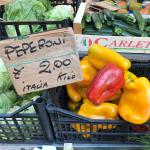 Bell peppers are grown around the world and are the most popular pepper type in the United States as a whole and in Massachusetts; however, many other types of peppers, including hot peppers, are growing in popularity. Peppers are tender perennials and can be grown in tropical regions for multiple years but are grown as annuals here in Massachusetts and should be transplanted outside only after the danger of frost has passed. The majority of pepper fruits start off green and will turn yellow, orange, or red when mature. As an example, Figure 3 shows mature red and yellow bell peppers for sale at a market in Milan, Italy--these peppers would have been green initially. The seeds in peppers are viable, meaning they can be saved and seeded to produce new plants when the fruit turns color. (Saving seeds for future plantings will be covered later in this series.)
Bell peppers are grown around the world and are the most popular pepper type in the United States as a whole and in Massachusetts; however, many other types of peppers, including hot peppers, are growing in popularity. Peppers are tender perennials and can be grown in tropical regions for multiple years but are grown as annuals here in Massachusetts and should be transplanted outside only after the danger of frost has passed. The majority of pepper fruits start off green and will turn yellow, orange, or red when mature. As an example, Figure 3 shows mature red and yellow bell peppers for sale at a market in Milan, Italy--these peppers would have been green initially. The seeds in peppers are viable, meaning they can be saved and seeded to produce new plants when the fruit turns color. (Saving seeds for future plantings will be covered later in this series.)
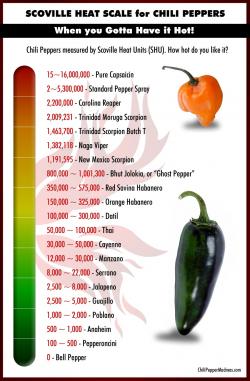 Hot peppers are classified by their level of “spiciness”, an attribute particular to peppers which derives from an alkaloid found in all peppers called capsaicin. The level of spiciness in a pepper is measured using the Scoville Heat Scale, developed in 1912 by Wilbur Scoville, a pharmacist in Connecticut. See Scoville Heat Units for selected peppers listed in Figure 4. On the bottom of Figure 4, you can see bell peppers have a value of “0” SHU, and the SHU ranking by pepper type increases as you go up the list.
Hot peppers are classified by their level of “spiciness”, an attribute particular to peppers which derives from an alkaloid found in all peppers called capsaicin. The level of spiciness in a pepper is measured using the Scoville Heat Scale, developed in 1912 by Wilbur Scoville, a pharmacist in Connecticut. See Scoville Heat Units for selected peppers listed in Figure 4. On the bottom of Figure 4, you can see bell peppers have a value of “0” SHU, and the SHU ranking by pepper type increases as you go up the list.
Habanero, along with Scotch Bonnet peppers, were two of the “hottest” types of peppers available for many years, ranging from 150,000 – 325,000 SHU (Figure 4). Habanero peppers get their name from La Habana, the Spanish name for Havana, the capital of Cuba. (Interestingly, hot peppers are not used in Cuban cuisine; you can’t find habanero peppers in Havana!) Spanish-speaking regions of the Caribbean, including the Dominican Republic, Cuba, Venezuela and Puerto Rico, mostly use sweet peppers. Many English and French-speaking countries in the Caribbean, including Haiti, Barbados, Jamaica, among others, make extensive use of habanero and Scotch bonnet peppers. Habaneros have since been replaced as the spiciest hot peppers by a large and growing list of new “hottest peppers in the world”, which are the results of newly established breeding programs. It seems like every few months there is a new “hottest pepper in the world”! The variety ’Carolina Reaper’ now tops the list, at 2,200,00 Scoville Units, which is ten times hotter than habanero peppers! (All the hot peppers above Orange Habanero in Figure 4, including Red Savina Habanero, have been developed relatively recently).
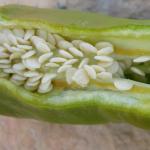 There is a common misconception that the seeds are the source of the “heat" in hot peppers; however, capsaicin is actually produced in the placenta (the white membrane within the pepper), where the seeds develop (Figure 5). Capsaicin will migrate from the placenta to the seeds and other parts of the fruit as it develops. So, if you want to reduce the heat of a hot pepper, remove both the seeds and placenta. If you ingest to much heat from hot peppers, consuming sugar, dairy products (sour cream, milk, yogurt) and starches (breads, tortillas, potatoes, or rice can help (Chile Pepper Institute: https://cpi.nmsu.edu).
There is a common misconception that the seeds are the source of the “heat" in hot peppers; however, capsaicin is actually produced in the placenta (the white membrane within the pepper), where the seeds develop (Figure 5). Capsaicin will migrate from the placenta to the seeds and other parts of the fruit as it develops. So, if you want to reduce the heat of a hot pepper, remove both the seeds and placenta. If you ingest to much heat from hot peppers, consuming sugar, dairy products (sour cream, milk, yogurt) and starches (breads, tortillas, potatoes, or rice can help (Chile Pepper Institute: https://cpi.nmsu.edu).
In 2013, a company in Massachusetts contracted with UMass to evaluate a type of hot pepper, “Trinidad Scorpion Peppers”, estimated to have between 1,000,000 and 1,400,000 SHU for production in Massachusetts. The company had been importing these peppers from India and wanted to find a local farm to grow them. We grew an acre of the peppers at our research farm in Deerfield, MA and kept track of all the production costs, yields, and returns so this information could be used by a commercial farm to be able to decide whether or not this crop was economically viable for them to grow.
In spite of the fact that this variety of pepper is unique for Massachusetts, we grew it like we would any other pepper variety:
- Produce transplants (Figure 6);
- Use biodegradable plastic on raised beds and transplant the peppers after the last frost, June 1 (Figure 7);
- Fertilize the peppers with drip irrigation and weed in between the rows with a tractor (Figure 8);
- Start harvest when some fruit matured (Figures 9 and 10);
- Put them in buckets to bring to the packing shed (Figure 11);
- Separate the seeds and calyx (Figure 12); and
- Pack a standard bushel 1/9 wax box for storage and delivery (Figure 13).
This pepper grew well, and we got good yields, but harvesting was an adventure – we had to wear masks, gloves, and long sleeves to harvest them. The company also required us to remove all the seeds and the stem, which we don’t do with other pepper varieties, and added extra cost for any farmers growing them. We know the grower contracted with another farm to grow these peppers in a greenhouse.
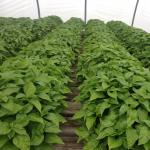


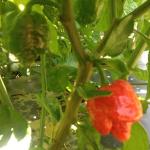
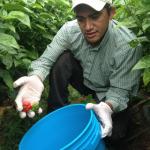

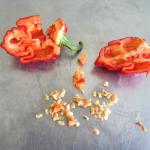

There is another group of peppers, C. chinese, that are mostly sweet and very popular among certain Latino ethnic groups which are not spicy, with multiple common names in Spanish, including aji dulce (ají is another word for pepper in Spanish derived from the Taino Indians of the Caribbean), ají cachucha and ají gustoso in Spanish, translating “sweet pepper”, “baseball cap shaped” pepper, and “tasty pepper. Ají dulce peppers are a staple predominantly in Puerto Rico, the Dominican Republic, Cuba and Venezuela. There are millions of these three ethnicities living in the Northeastern United States and this has represented opportunities for local farmers to grow these peppers for this market. We maintain a website with information on the production, marketing and nutrition for this pepper, which includes pictures, videos, culturally-appropriate recipes at https://worldcrops.org/crops/aji-dulce.
Weekly Video Update
Weekly Video Update at Franco's Garden (from 6/7/20)